Get PeakVisor App
Sign In
Search by GPS coordinates
- Latitude
- ° ' ''
- Longitude
- ° ' ''
- Units of Length

Yes
Cancel
Share ×

Scan the QR code and open PeakVisor on your phone
❤ Wishlist ×
Choose
Delete
Israel, officially the State of Israel (pop 9.3 million), is a small, ethnically Jewish nation in the Levant region of the Eastern Mediterranean. Jewish, Christian, and Muslim communities consider this geographically diverse country the Holy Land. Clockwise from the north, it shares borders with Lebanon, Syria, Jordan, and Egypt. Israel also neighbors the Palestinian territories of the West Bank and Gaza Strip and has a coast along the Mediterranean and the Red Sea. There are 1007 named summits within modern-day Israel, though some are within annexed regions (recognized by many nations, including the UN). Mount Duvdevan (2,236 m/7,336 ft), also known as Mount Hermon, is considered Israel’s highest peak but is situated within the Golan Heights. If only including traditional Israeli territory before the 1967 Six-Day War, then the country’s highest and most prominent peak is Mount Meron (1,208 m/3,963 ft).
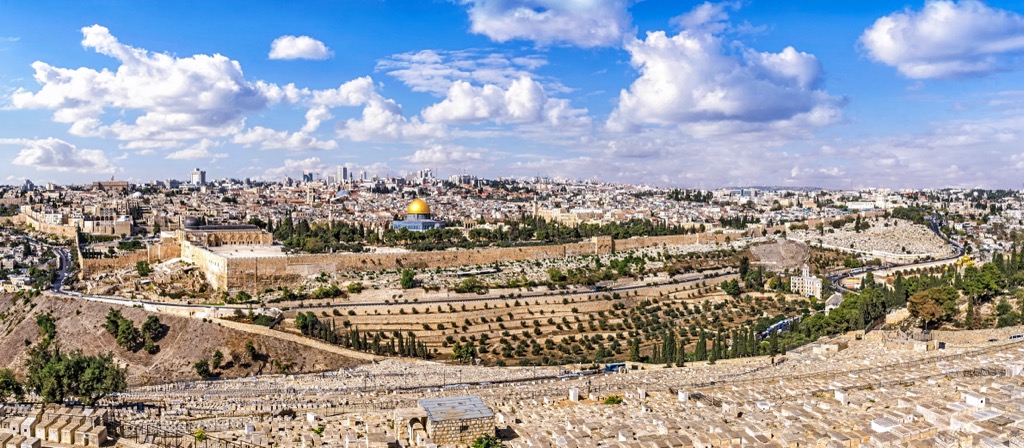
Israeli territory spans between 20,700 and 22,000 square kilometers (51,115,081 and 5,436,318 acres). The former number denotes Israeli land within the Green Line (the demarcation line declared by the armistice after the 1948 Arab–Israeli War). The latter includes East Jerusalem (former Jordan) and Golan Heights (former Syria), regions of modern-day Israel annexed in 1980-81, following Israeli occupation after the 1967 Six-Day War.
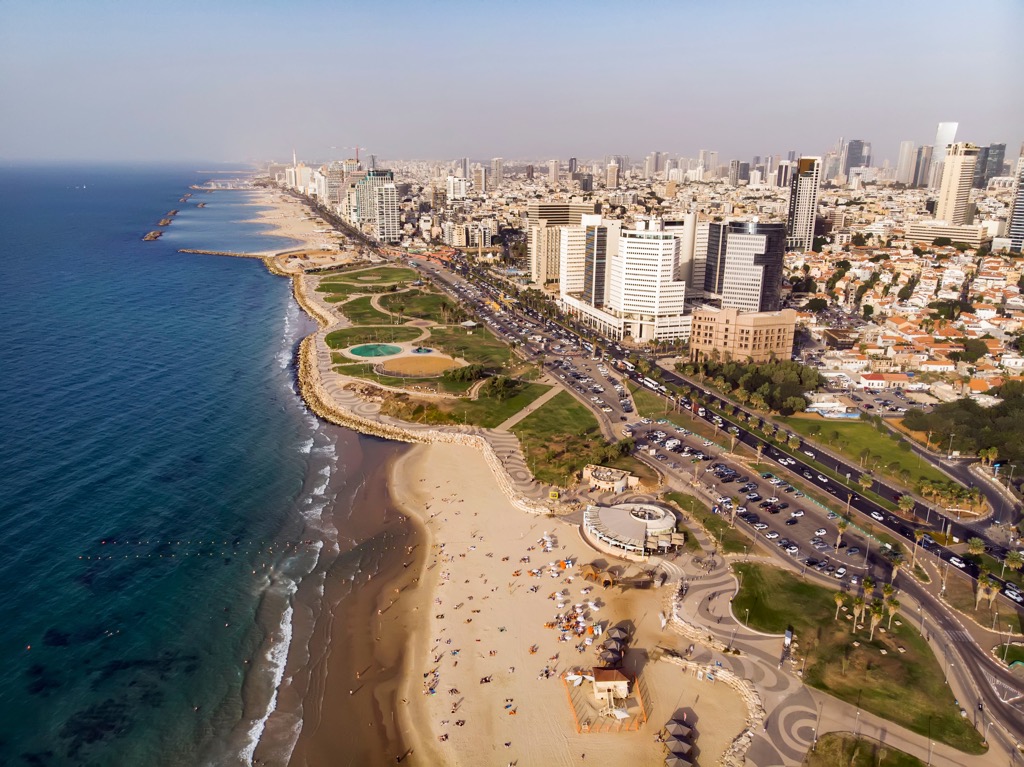
Four distinct regions make up Israel’s geographic scope: the coastal plain, the central hills, the Jordan Rift Valley, and the Negev Desert.
The coastal plain, along the Mediterranean, is where most of the population resides, and it offers sandy beaches and bustling port cities like Tel Aviv and Haifa. The central hills form the backbone of Israel and hold immense historical, cultural, a religious significance for all three Abrahamic faiths: Christianity, Islam, and Judaism.
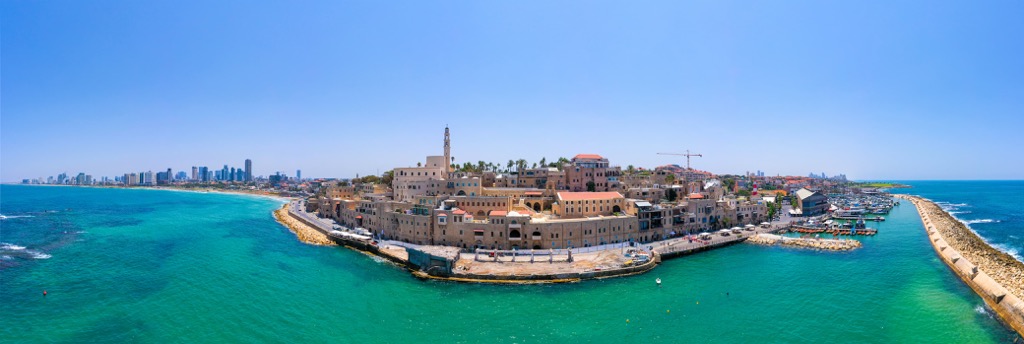
The Mediterranean Sea lies directly west, making up much of the country’s 273 km (170 miles) coastline, although a small coast along the Red Sea marks the southern tip of Israel. The Mediterranean coastal plain spans 185 km (115 miles) in length and around 40 km (25 miles) in width. The coastline features sandy beaches that quickly give way to fertile farm and agricultural lands.
The central hills include the Galilee, Samarian, and Judean ranges. They range between 500 meters (1,640 ft) and 700 meters (2,297 ft) and are much lower than peaks elsewhere in the Levant Ranges. In the far northeast, they rise to high points in Golan, crowned by Mount Duvdevan (2,236 m/7,336 ft).
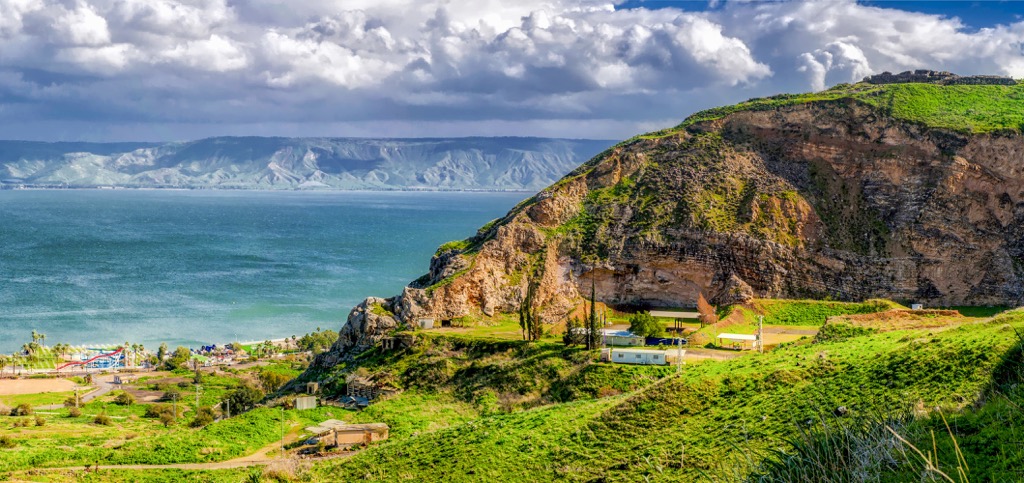
To the east lies the Jordan Rift Valley, a dramatic geographical feature extending from the Sea of Galilee in the north to the Red Sea in the south, following the mighty Jordan River, Israel’s largest at 322 kilometers (200 mi).
The Jordan Rift Valley is home to the Dead Sea, which, at 430 meters (1,412 ft) below sea level, is the lowest point on Earth’s surface. It is known for its high salt concentration and therapeutic properties. With nearly 35% salinity content, the sea supports no plant or animal life (and only a small amount of microbial life), hence its name.
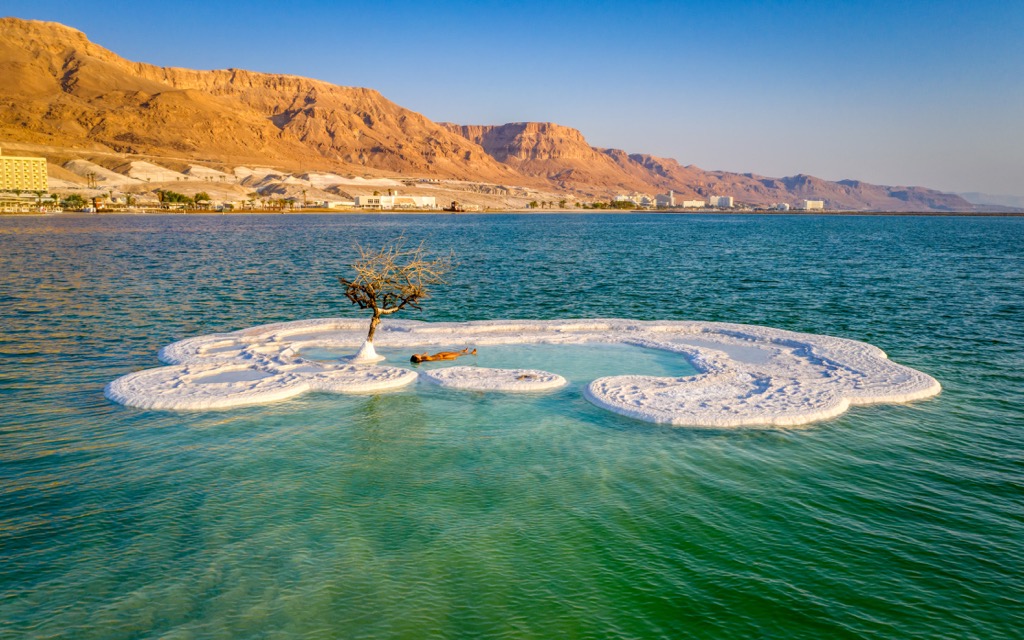
Since it’s ten times saltier than the ocean, swimming is comparable to floating. A changing climate has brought hotter and drier conditions to the region, while water continues to be siphoned out for agricultural purposes. As a result, the Dead Sea has lost nearly half of its surface area in the last hundred years and has become significantly saltier.
Beyond the Jordan Rift Valley, the landscape rises into the Negev Desert, an expanse of arid land dotted with unique rock formations, ancient archaeological sites, and Bedouin communities, also home to an eponymous mountain range crowned by Mount Ramon (1,035 m/3,396 ft). At 12,000 square kilometers (2,965,264 acres), the Negev makes up over half of Israel’s land area.
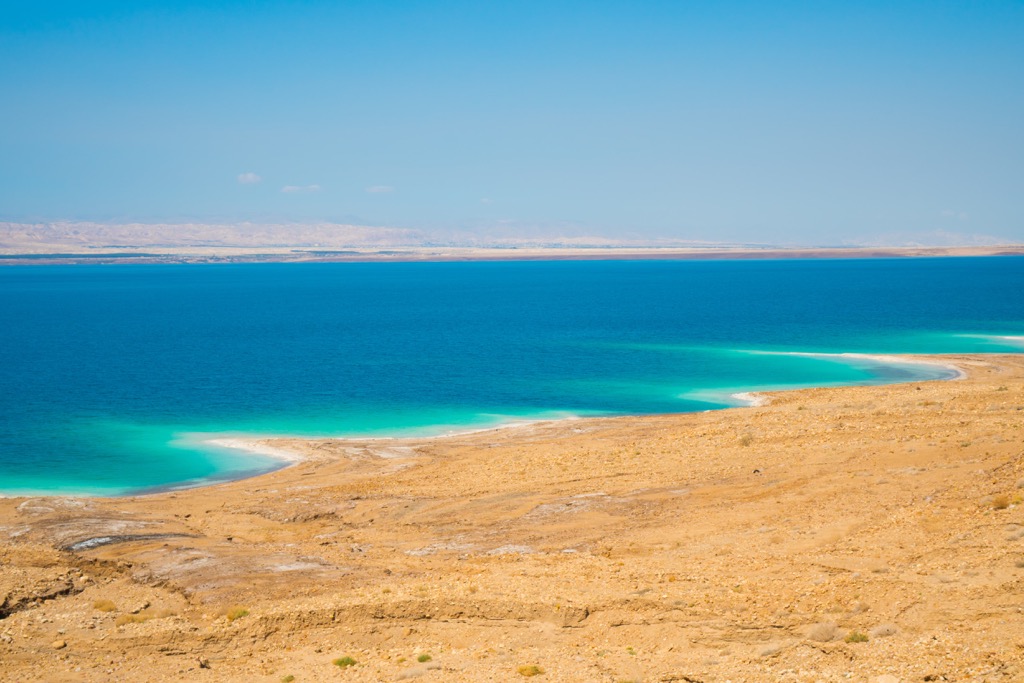
Israel's climate is primarily Mediterranean, with warm, temperate summers and mild, wet winters. The average summer temperature in Tel Aviv is 29℃ (84℉), and in winter is 15℃ (59℉). In the south, the climate tends more towards that of an arid desert, with sweltering heat in the summer days and near-freezing cold in the winter nights.
Israel is home to numerous protected areas and national parks. Some of the most visited places for hiking include the Negev Mountains Nature Reserve, Ein Gedi National Park, Ben Shemen Forest, Masada National Park, Mount Carmel National Park, and Nahal Kziz Nature Reserve.
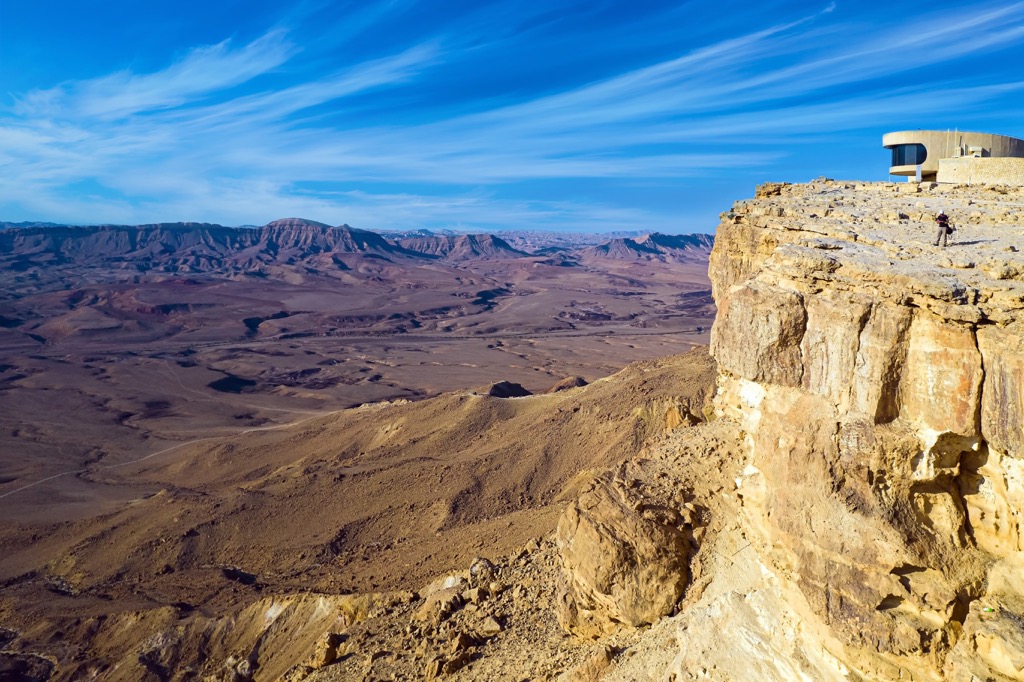
The geology of Israel is complex and varied, reflecting the country's location at the crossroads of three tectonic plates—the Arabian, African, and Eurasian.
The central hills of Israel, including the Judean Mountains and Samarian Hills, are part of the Arabian Plate. The Jordan Rift Valley, meanwhile, was formed during the Miocene epoch (beginning 23.8 million years ago), when the Arabian Plate pulled away (north and east) from the African Plate. This divergent movement also created the Dead Sea.
The oldest rocks in Israel are Precambrian igneous and metamorphic rocks that date back over 2 billion years. These are notably exposed in the south of the country, in the Eilat Mountains.
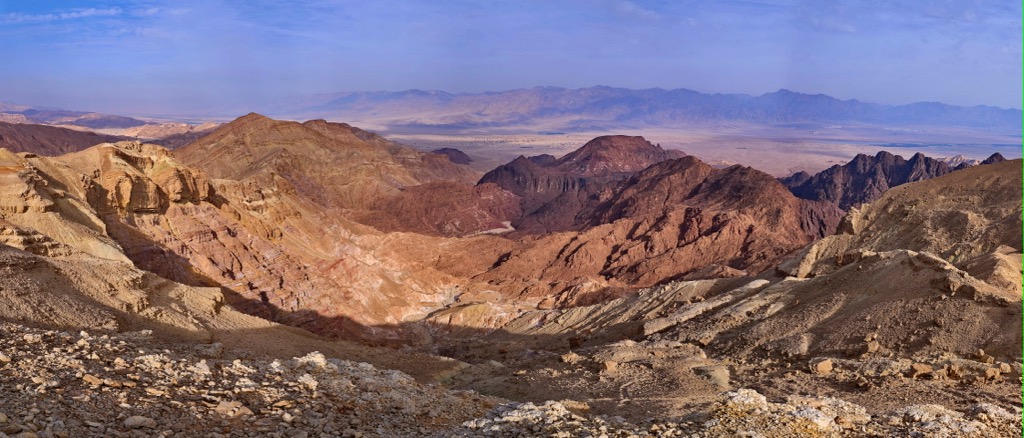
Overlying the Precambrian rocks are sedimentary rocks deposited during the Paleozoic, Mesozoic, and Cenozoic eras, including limestone, sandstone, shale, and dolomite. These sedimentary rocks are most prominent in the Judean Hills, the Golan Heights, and the Negev Mountains and desert. The youngest rocks in Israel are alluvial deposits—found in the valleys and along the coast—deposited in recent millennia, including sand, gravel, and clay.
Significant peaks in Israel include Mt. Hermon, Mount Mermon, Ramon, Givat HaMore, and Yona.
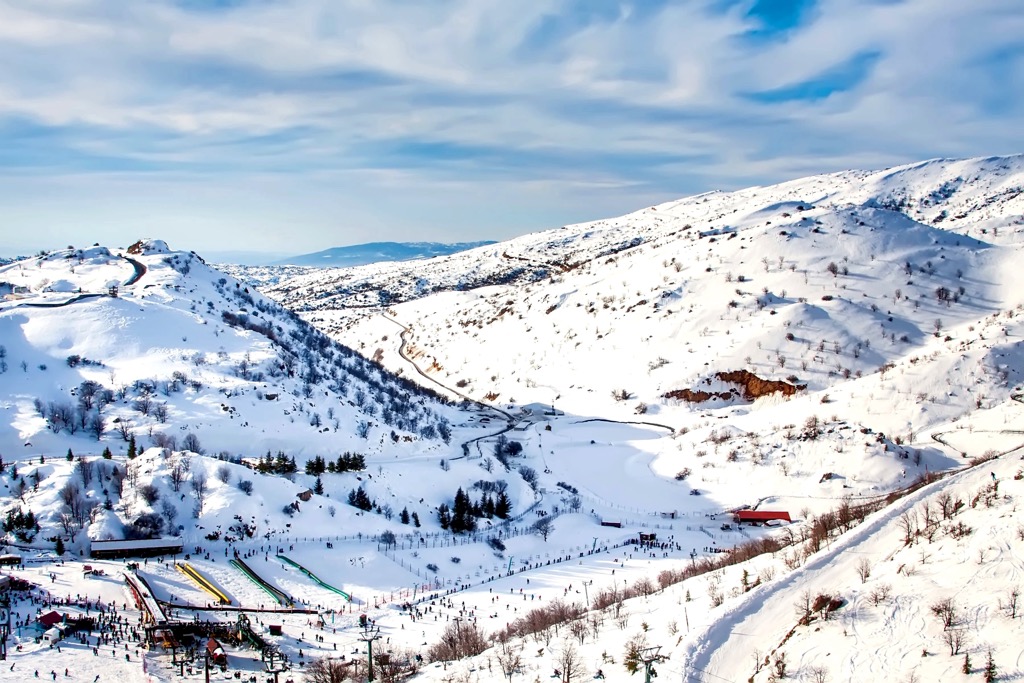
Despite its relatively small size, Israel is home to diverse ecosystems in terms of flora and fauna. The coastal areas host sandy beaches and fertile plains with groves of citrus, palm, olive, and fig, as well as shrubs such as tamarisk and oleander.
The central hills, meanwhile, are covered with traditional Mediterranean vegetation, including oak, cypress, and pine forests, along with shrubs like sage, lavender, and rosemary. Arid landscapes characterize the vast Negev Desert in the south. Still, even in this seemingly harsh environment, various species of desert plants thrive, such as acacia, jujube trees, and many cacti and succulents.
The desert is also home to many unique mammal species, including desert foxes, Nubian ibex, Arabian oryx, and leopards. Gazelles, hyenas, jackals, and wolves are also common. There are over 100 mammal species in Israel, nearly 60 of which are endangered.
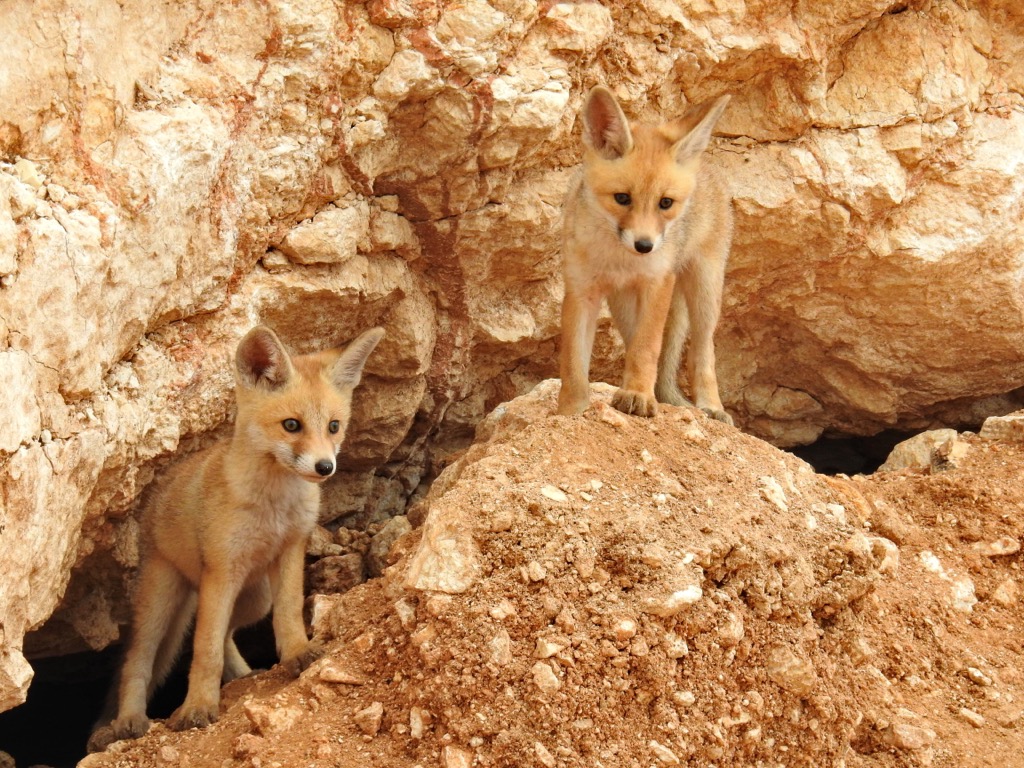
There are also around 100 species of reptiles in Israel, primarily in the north—including Sinai fan-fingered geckos, Caspian turtles, Savigny's agama lizards, Spotted desert racers, and Saharan sand vipers.
The number of amphibians has dramatically diminished throughout the last century due to the destruction of vital wetlands and swamps. The most common amphibian is the European green toad. Another notable rare example is the endemic Hula painted frog, thought to be extinct until it was rediscovered in 2011 in the Lake Hula marshes.
The Mediterranean and Red Seas are home to numerous species of fish. Rare fish include the Yarkon bream and Palestine Loach.

Hundreds of bird species live in Israel, while many pass through the region when migrating between Europe, West Asia, and Africa. Birdwatchers should look for species like the Griffon vulture, houbara bustard, golden eagle, sandgrouse, black-eared wheatear, monk parakeet, great tit, and Nubian nightjars.
Due to the perenially mild climate, subtropical fruit and citrus groves thrive in places where irrigation is available.
Humans have inhabited the region that is now Israel for thousands of years. Archaeological evidence suggests that humans lived in the area as early as the Paleolithic period (200,000 BCE). Early human settlements left traces of stone tools and artifacts indicating a hunter-gatherer lifestyle.
Around 10,000 BCE, during the Neolithic period, the transition to agriculture and domestication of animals occurred in the Levant region, including present-day Israel. This transition led to permanent settlements and the establishment of villages. During the Bronze Age (3,300–1,200 BCE), Israel was home to several prominent civilizations. Among them were the Canaanites, who inhabited the fertile plains, and the Philistines, who settled along the coast.
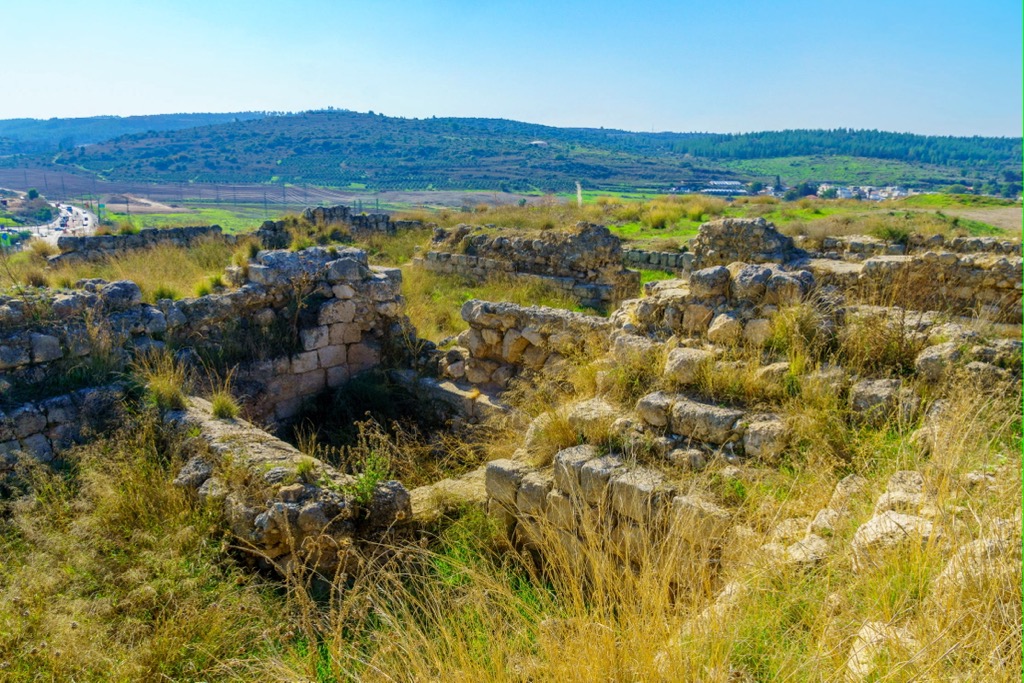
The Hebrew Bible (Torah), a significant historical and religious text, mentions the early history of the Semitic-speaking Israelites. According to the biblical narrative, the Israelites were descendants of Abraham and migrated from Mesopotamia to the land of Canaan. Around the 12th century BCE, the Israelites established a monarchy, dividing the land into the kingdoms of Israel in the north and Judah in the south. The two united briefly under King David and his son, Solomon.
In 722 BCE, the Assyrians conquered the Kingdom of Israel, exiling the ten northern tribes. Judah lasted until 586 BCE, when Babylonians captured Jerusalem and destroyed the First Temple, leading to the Babylonian captivity and exile. Following the fall of Babylon, the Persians conquered the region, and the exiled Jews were allowed to return to Jerusalem and rebuild the Second Temple. This period marked a time of relative prosperity and autonomy for the Jewish community.
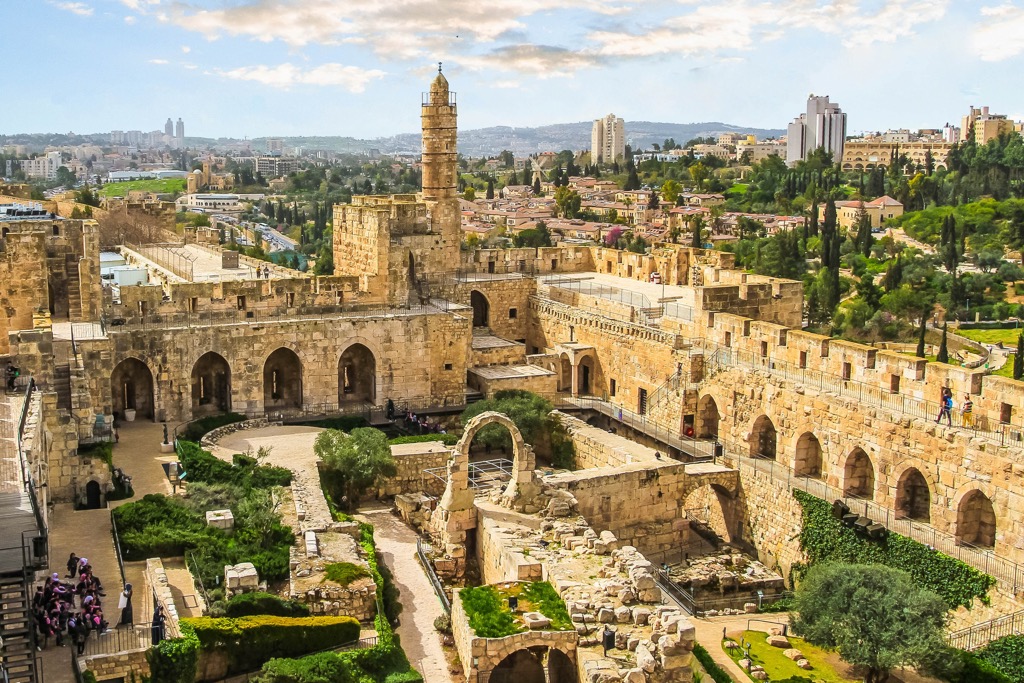
Alexander the Great's conquests eventually brought the region under Hellenistic influence. After his death, the region fell under the control of the Seleucid Empire. The struggle for religious freedom and independence led to the Maccabean Revolt in the 2nd century BCE, establishing the Hasmonean dynasty.
In 63 BCE, the Romans under Pompey conquered Jerusalem, and Israel became a Roman province. The region witnessed significant Jewish resistance, culminating in the First Jewish-Roman War (66–73 CE). The destruction of the Second Temple in 70 CE and the subsequent Bar Kokhba Revolt (132–136 CE) led to a widespread Jewish diaspora. Christianity emerged during this period, and the region became an important center for early Christian communities.
The Byzantine Empire later ruled the land, but by the 7th century, Muslim armies had captured Jerusalem from the Byzantines, making it an important city in the Islamic world. Subsequently, Islam became the region’s dominant religion, coexisting with Christian and Jewish communities.
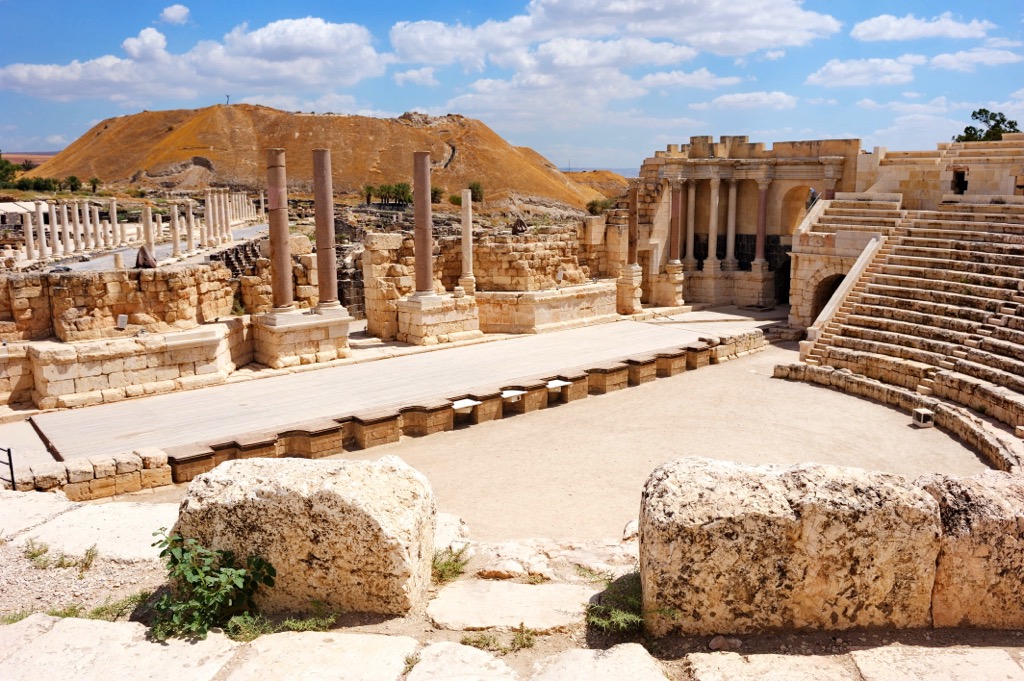
During the Middle Ages, Israel was a prominent focal point for the Crusades, a series of military campaigns launched by European Christians to reclaim Christian holy sites in the Levant. Jerusalem changed hands several times between Muslim and Crusader forces during this period.
The Ottoman Empire, under Sultan Selim I, ultimately conquered the region definitively in 1517, marking the beginning of several hundred years of Ottoman rule. The Ottomans ruled until the end of World War I. Following the Central Powers' defeat, they ceded modern-day Israel's land to the League of Nations. This territory then fell under the British Mandate for Palestine (est 1920).
The 20th century saw a significant influx of Jewish immigrants to Palestine, driven by the Zionist movement, which aimed to establish a Jewish homeland. On May 14, 1948, the British Mandate ended. David Ben-Gurion, the head of the Jewish Agency, then declared the establishment of the State of Israel and became its first Prime Minister.

Israel’s inception was followed by a war with neighboring Arab states (1948 Arab-Israeli War), many of whom it continued to feud with throughout the 20th century. During the war, over 700,000 Palestinian Arabs fled Israel for Gaza and the West Bank, while over 250,000 Jews emigrated and fled from Arab nations to Israel.
Battles between Israel and various Arab countries resulted in the Six-Day War in 1967. Israel has since annexed East Jerusalem and Golan Heights, efforts that international law views as illegal.
Israel’s relations with many other nations in the Middle East and Palestinian territories remain fraught with conflict today. Palestine, officially the State of Palestine, has territorial claims, including the West Bank and the Gaza Strip, under Israeli occupation since the Six-Day War. Both Israel and Palestine claim Jerusalem as their capital.
Modern-day Israel comprises six administrative regions: the Northern District, Jerusalem District, Haifa District, Tel Aviv District, Central District, and Southern District.

Despite its relatively small size, Israel offers a wealth of outdoor opportunities. This tiny nation has a whopping 81 national parks and 400 nature reserves. Natural protected land makes up around 20% of Israel’s land mass. Below are a few of the most popular hiking destinations.
Perched high on an isolated rock plateau overlooking the Dead Sea, Masada (63 m/207 ft) is an iconic hiking destination with significant historical importance. Situated within Masada National Park, the site is a UNESCO World Heritage Site and holds the remnants of a fortress built by King Herod the Great from around 30 BCE.
Visitors access the park via cable car or a steep hiking path and have sweeping views of the Dead Sea and Jordan in the distance. The top of Masada rewards adventurers with breathtaking views of the desert landscape. The park hosts nighttime light shows, concerts, and operas throughout the year.
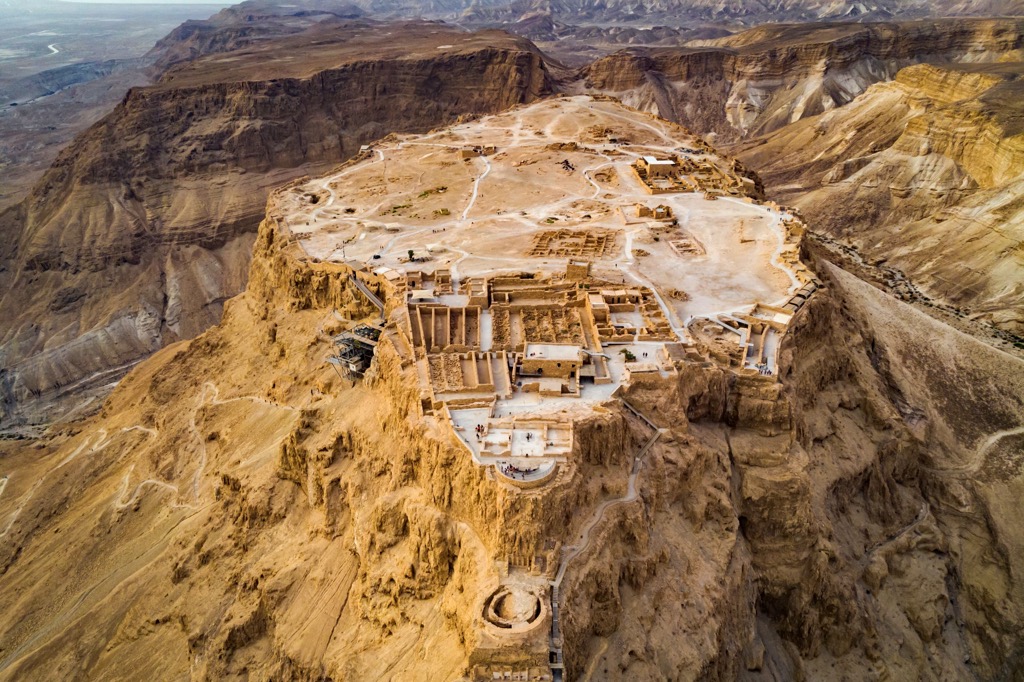
Mount Carmel (546 m/1,791 ft), a coastal massif in northern Israel’s Haifa District, offers a range of hiking trails suitable for all levels of hikers. Mount Carmel National Park marks the largest national park in Israel. Encompassing the Carmel Mountains, the park includes over 10,000 hectares (24,711 acres) of cypress, pine, and eucalyptus forest.
The Carmel National Park and Nature Reserve is home to diverse flora and fauna, and visitors can explore the wooded slopes, rocky terrain, and hidden caves. Rolling green slopes and peaks feature common Mediterranean plants. The park is home to numerous nature reserves and over 250 archaeological sites. There are multiple hiking and biking paths throughout. One highlight is the Carmel Hai-Bar Nature Reserve, where endangered species are protected.
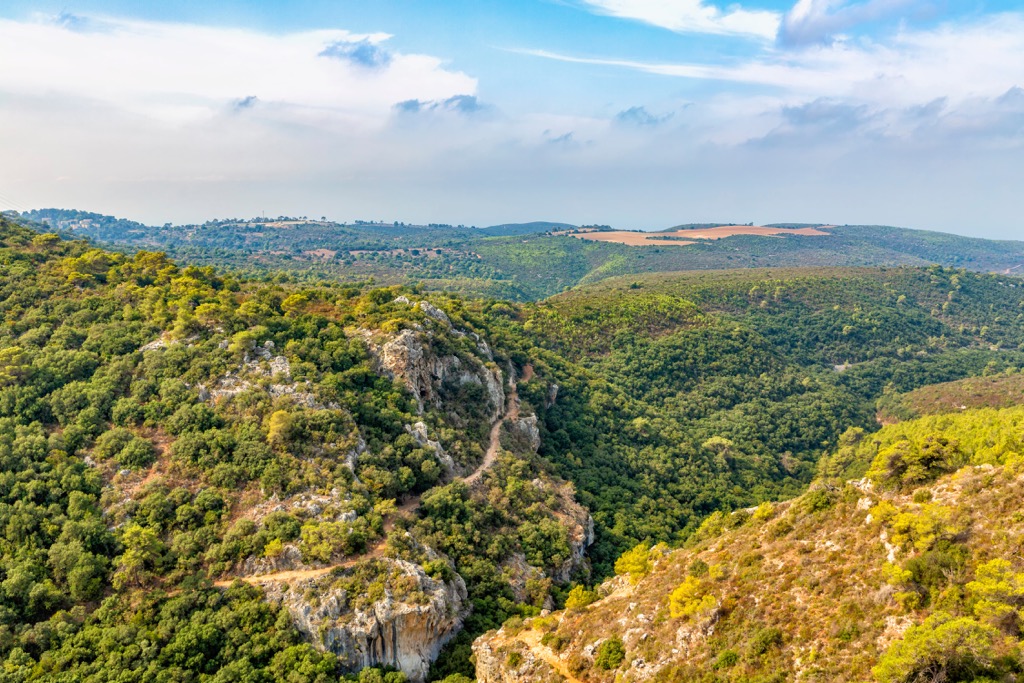
Located along the shores of the Dead Sea, the Ein Gedi Nature Reserve is an oasis in the Negev Desert desert; the park is the country’s largest desert oasis.
The reserve features several hiking trails that lead to lush oases, waterfalls, and natural pools. Popular sites include David Waterfall, Arugot Stream, and the Oasis Trail. A temple and the remnants of a 2,000-year-old village may also appeal to visitors. The wildlife and vegetation in this reserve are exceptional, and hikers may spot ibexes, hyraxes, and various bird species during their trek. The reserve is home to seven peaks, the highest and most prominent point being Avishay (240 m/787 ft).
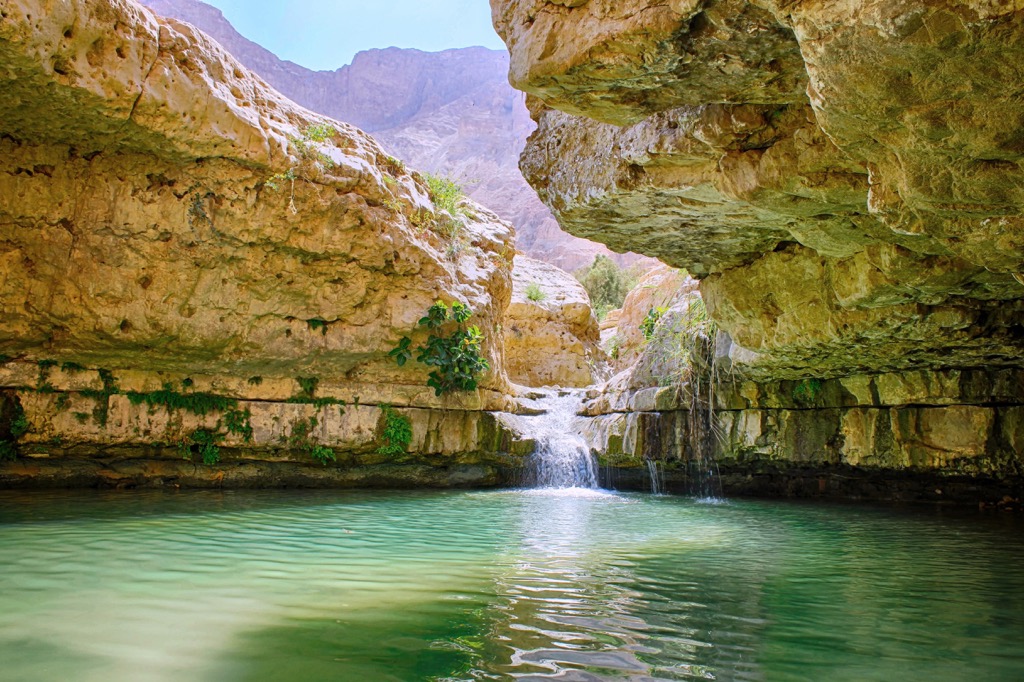
Jerusalem (pop. 875,000), Israel's capital and largest city, is a place of spiritual significance for billions of people worldwide. It is home to sacred sites like the Western Wall, the Church of the Holy Sepulchre, and the Dome of the Rock. Other popular sites include the Israel Museum-Jerusalem, Gethsemane, Machaneh Yehudah Market, Tower of David, and Yad Vashem.
Jerusalem is considered one of the oldest cities in the world. The Old City, a UNESCO World Heritage Site, is a labyrinth of narrow streets and ancient sites, each representing a different chapter in history. Visitors can immerse themselves in the rich tapestry of cultures, religions, and traditions that converge in this extraordinary city. Mount Ora (857 m/2,802 ft) is the highest peak in the Jerusalem District.
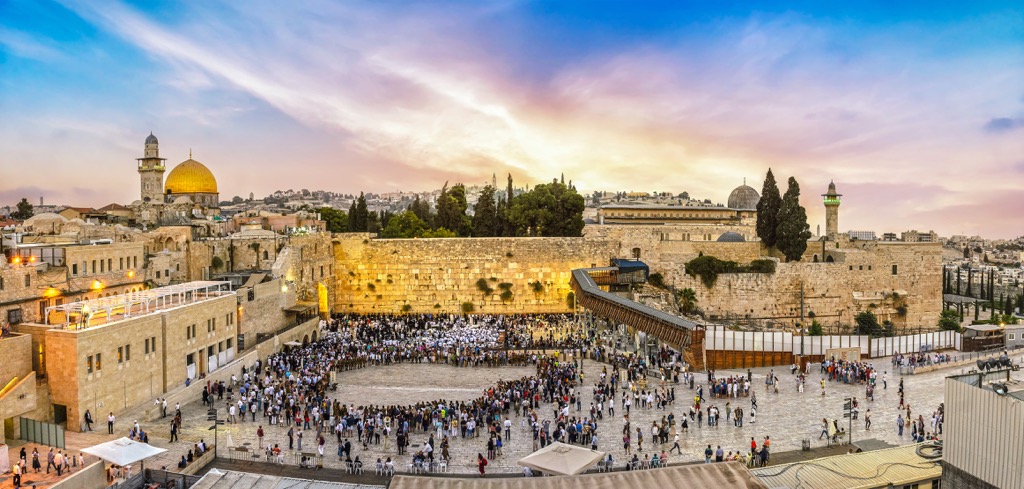
Tel Aviv (pop. 436,000), Israel's cultural and economic hub, offers a vibrant and modern urban experience. The juxtaposition of ancient history and contemporary living is evident as visitors stroll along the bustling streets and visit world-class museums and art galleries. The highest and most prominent peak in the Tel Aviv District is Chiriya (75 m/246 ft).
Known for its stunning beaches, lively nightlife, and innovative culinary scene, Tel Aviv is a city that never sleeps. The city is the country's economic center and prominent in the tech industry. It features a thriving nightlife and food scene. Popular sites include Sarona Market, Tel Aviv Museum of Art, Carmel Market, Beit Hatfutsot, and the Eretz Israel Museum.

The White City of Bauhaus in Tel Aviv consists of over 4,000 buildings built during the 1930s. Designed by Jewish architects, the region is often called the world capital of Bauhaus buildings; these structures feature clean lines, little decoration, and rational use of modern industrial materials such as glass, concrete, and steel.
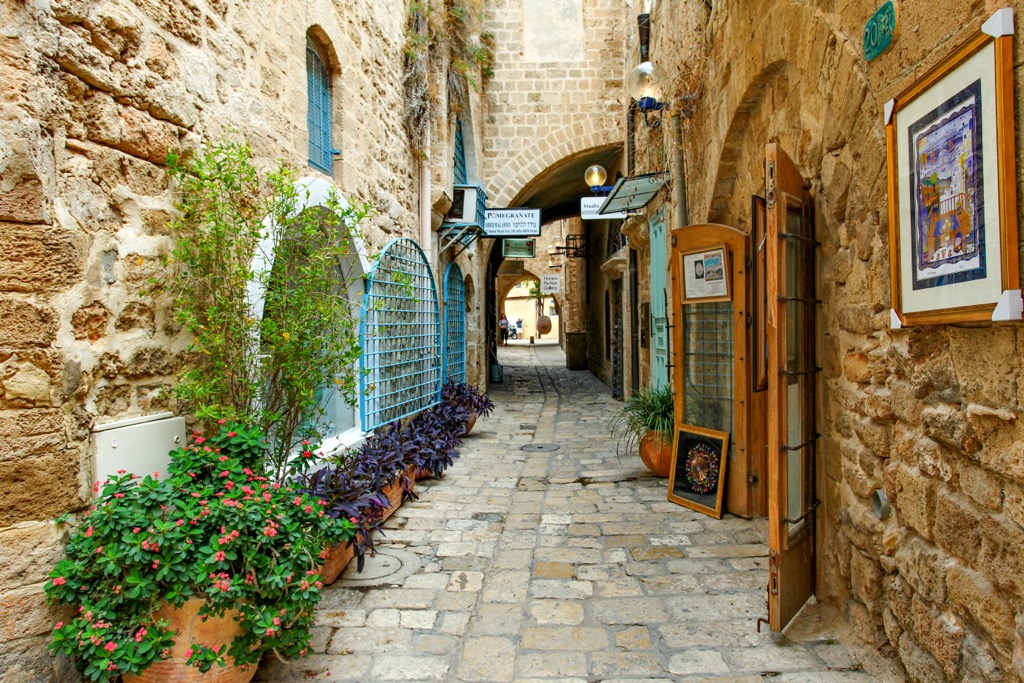
Situated on the slopes of Mount Carmel (546 m/1,791 ft), Haifa (pop. 280,000) is a city of natural beauty and cultural diversity. The city's panoramic views of the Mediterranean Sea and its bustling port make it a fascinating destination. Haifa is also home to the beautiful Bahá'í Gardens, a UNESCO World Heritage Site and a symbol of the Bahá'í Faith's significance in the city.
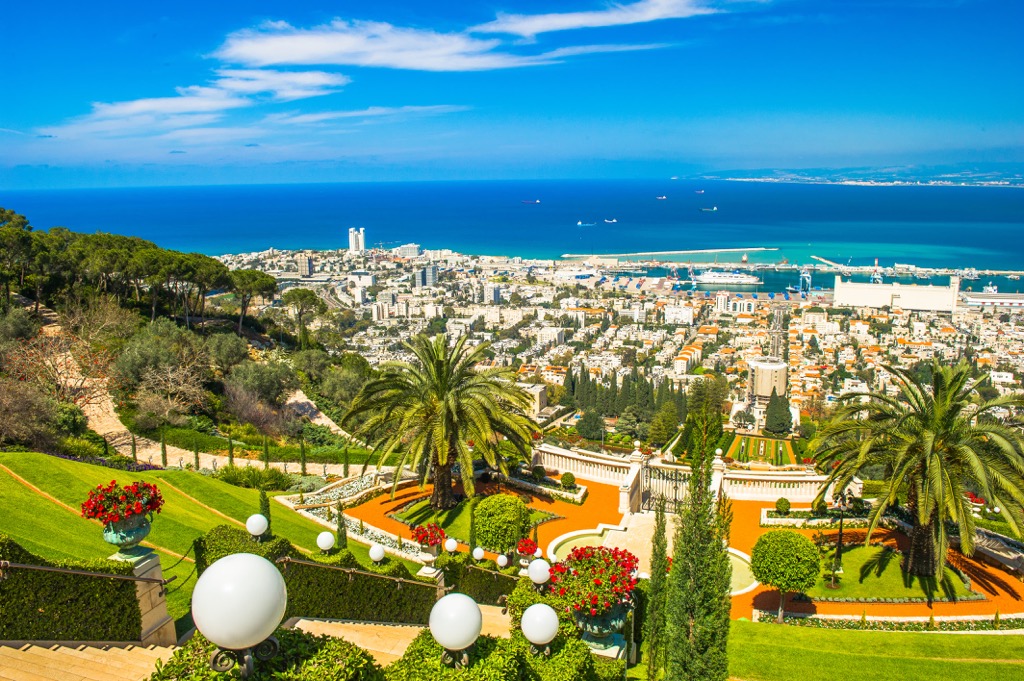
Explore Israel with the PeakVisor 3D Map and identify its summits.








